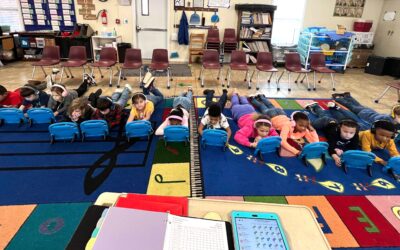When parents or grandparents say that their children or grandchildren can use technology better than they can, they’re usually only half joking. After all, it seems children of nearly any age can quickly figure out how to navigate most digital devices, such as smartphones and gaming consoles. However, while many of these skills seem to come naturally to children, keyboarding remains a skill that requires instruction and practice to master.
Since education and professional environments alike are becoming increasingly digitally based, there’s little argument that keyboarding is important for students. But at what age should students begin to learn keyboarding?
At What Age Should Children Start Learning Keyboarding?
Children can start learning early keyboarding skills as young as 5 or 6 years old. However, it’s important to keep in mind that students at this age will not have the motor coordination to fully master typing yet—and may not even have hands large enough to rest their fingers on home row.
At ages 5 or 6, students can begin learning early typing concepts such as home row, posture, letter sequencing and more that will be built upon in future ages.
Why Start Students on Keyboarding Young?
It’s important to start students in keyboarding early so they don’t develop poor typing habits. As technology is introduced earlier and earlier to students, they are introduced to the necessity of having to type, most likely on a touchpad at first. These early introductions reinforce the idea of pecking, or typing with just one or two fingers, as opposed to using all fingers as with a traditional keyboard. As students engage longer and longer in pecking, it becomes increasingly more difficult to break the habit once a real keyboard is introduced.
Another reason it is important to teach students keyboarding early is that they will be using this skill earlier in life than students did in the past. Where older generations sometimes wouldn’t learn keyboarding until college or university, this was largely because they didn’t need to utilize these skills until later in their educational and professional careers. However, students in early elementary school are now more likely to be utilizing computers—and keyboards—for lessons, projects, and practice earlier than ever. Having a solid set of keyboarding skills, or at least the foundational knowledge to begin building these skills, means students will be better able to focus on lesson material than on trying to find each letter on the keyboard.
How to Introduce Keyboarding to Young Students
For very young students, such as kindergartners, it’s important to have lessons and skill expectations that are age appropriate. Students this young likely aren’t ready to start doing typing speed drills but will benefit from becoming familiar with the functionality of the keyboard and letter placement. They can practice things like posture and hand placement, key sequencing, and understanding key combinations such as using the shift key to capitalize letters or type special characters.
In general, it is easiest and most successful to introduce keyboarding to young children through a formal online typing program that has lessons specifically for the age you are teaching. One such program is Learning.com’s adaptive keyboarding program for students as young as kindergarten. To learn more about this program, click the button below.

Learning.com Team
Staff Writers
Founded in 1999, Learning.com provides educators with solutions to prepare their students with critical digital skills. Our web-based curriculum for grades K-12 engages students as they learn keyboarding, online safety, applied productivity tools, computational thinking, coding and more.
Further Reading
Digital Skills for North Carolina Students
In our district, like most others, the use of digital learning tools has catapulted since the pandemic. With students online more than ever, it’s...
Why Teaching Kids to Code Supports Community Development
Teaching kids to code undoubtedly prepares them for the future of work. But what does this mean for the communities that helped them become career...
Enhancing Digital Citizenship by Understanding Confirmation Bias
Teaching confirmation bias as part of the digital literacy curriculum in schools is essential in today's information-saturated world. Confirmation...




